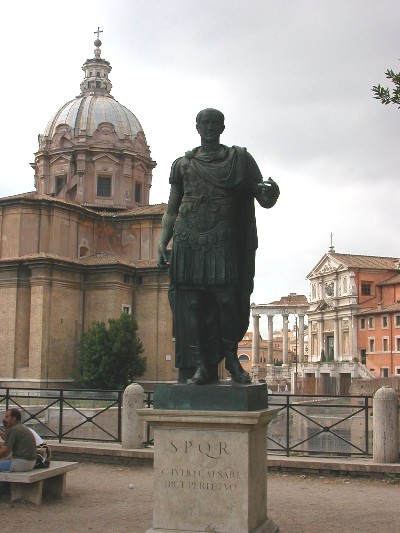|
|
 |
|
The Forum Romanum |
|
written
by eatonj / 09.01.2004 |
|
|
| |
Patron |
| |
| |

|
| Photo taken by Jeff Eaton |
| Julius Caesar |
| Here is a statue of Julius Caesar which stands on the sidewalk along Fori Imperialli, the main road running to the north of the Forum |
| |
|
| |

|
| Photo taken by Jeff Eaton |
| Augustus |
| An ancient statue of the Emperor Augustus housed in the Museo Nazionale Romano |
| |
|
| |

|
| http://free.freespeech.org/ascardan/diocletian.jpg |
| Diocletian |
| A bust of the emperor Diocletian who rebuilt the Forum after the great fire in 283. |
| |
|
Over its history there were literally hundreds of patrons of the Forum, but more than others, a few shaped the Forum into the way we see it today. The first patrons, who’s contributions are likely more mythological than not, were the first three kings of Rome. The great Romulus is credited with building the very first Temple of Jupiter on the Capitoline. The second king, Numa Pompilius, known for bringing religion to the kingdom, is said to have built the Temple of Vesta and the Regia, which was the holy residence of the kings and later in the Republic of the Pontifex Maximus. Tullus Hostilius, third king of Rome, known as the warlike king, brought order to the kingdom by establishing the Curia and the Comitium, sites from where the kingdom could be justly and methodically ruled. Even through these tales of ancient kings we can see how each patron tailored his buildings towards the development of the Rome and catered his building plans toward necessities for growth and organization of the kingdom during his reign.
Through the Republic, with consulships changing hands annually, there was not much time for large scale building plans, and thus during the Republic we see no outstanding patrons, nor specific architectural directions. Instead small uncoordinated monuments seem to spring up everywhere in the Forum, though not in a very permanent fashion. What we do see however is the first episodes of large scale civil engineering undertaken by the state since the Cloaca Maxima with the Via Appia providing paved road from Rome to Brundisium and the construction of aqueducts to give the city running water. While these were not specific to the Forum, they still today attest to the abilities of cooperative Republican power. Built out of necessity, such public works projects remind us of the first projects undertaken during the colonization of Africa during the 1800s and the urbanization of nearly any other rural area.
At the rise of the Empire under Julius Caesar Rome was now a solidified power controlling the Mediterranean, and there was a need for a single, unparalleled testament to the centralized dictatorship which Caesar secretly envisioned Rome to become. With this in mind, he completely remodeled the Forum to display much more grandeur than before. He constructed a new and impressive Curia, the enormous Basilica Julia, and rebuilt the Rostra to be more daunting than before. Now instead of coming to the Forum and simply seeing a political and commercial center where citizenry met to attend to the day’s business, one found a place like none they had seen before, demanding the respect owed to the colossal empire. Caesar’s adopted son and heir, Octavian Augustus, continued the aggrandizement of the Forum, and built a temple deifying Julius Caesar in honor of what he had done for the Republic (as the empire was still living under the guise of a republic). Furthermore he made a point of constructing an overly lavish palace for himself along with a temple for his favorite god Apollo on the Palatine hill. This made the Forum area not only a sign of Imperial power, but also of a sign of the might of the emperor himself.
Each subsequent emperor naturally had the goal of enhancing the Forum in order to capture the hearts and minds of the people. Some succeeded in their works, and some did not, but it is likely that we can tell how a particular emperor fared by studying how well his works fared and if they were in good favor, as this is how closely tied together the two phenomena are. Many of the better off emperors even built their own fora by which they could be personally remembered, example Trajan, whose forum you can read about in another article on this site. The later emperor with the greatest opportunity to shape the Roman Forum was Diocletian who came to power in 284 after the great fire of 283 that demolished nearly the entire Forum. Diocletian used this opportunity to rebuild the Forum as nearly an exact replica of what had stood before, adding only a set of honorary columns, thus showing stability and continuity of the empire along with its growing power, signified by rebuilding what had once stood, but even grander than before.
|
| |
|
| |
|
|
 |
|

